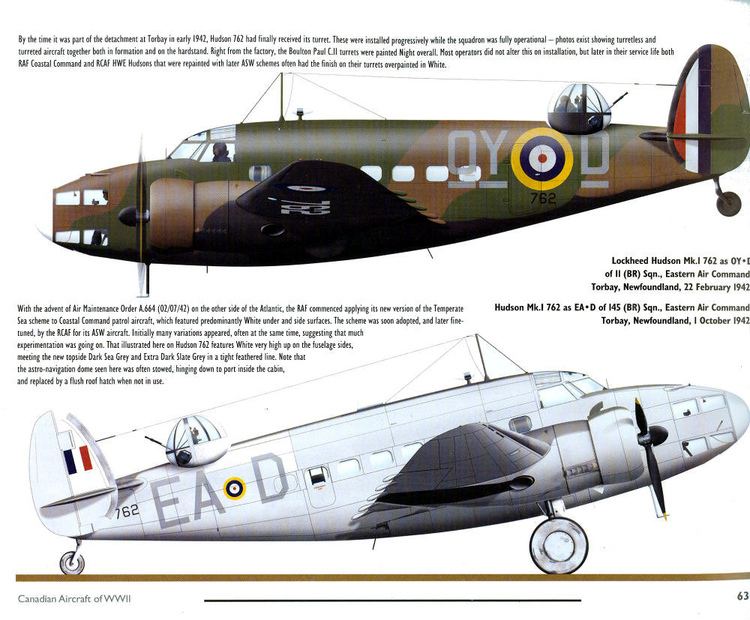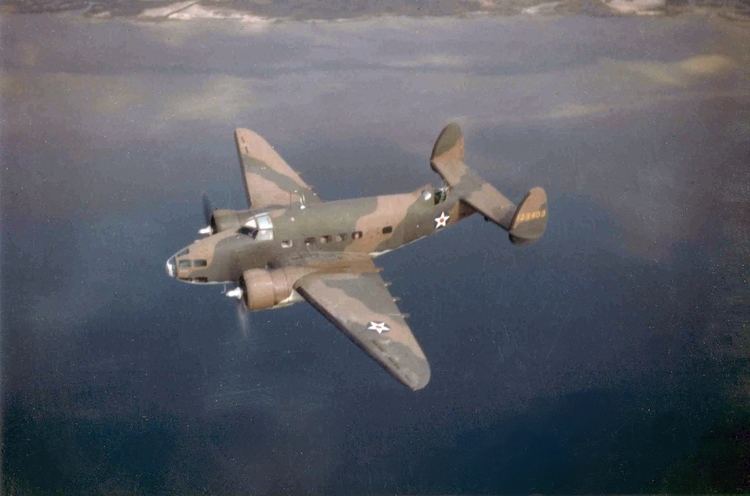Top speed 404 km/h Length 14 m Engine type Radial engine First flight December 10, 1938 | Wingspan 20 m Introduced 1939 | |
 | ||
Forgotten aircraft lockheed hudson bomber
The Lockheed Hudson was an American-built light bomber and coastal reconnaissance aircraft built initially for the Royal Air Force shortly before the outbreak of the Second World War and primarily operated by the RAF thereafter. The Hudson was the first significant aircraft construction contract for the Lockheed Aircraft Corporation—the initial RAF order for 200 Hudsons far surpassed any previous order the company had received. The Hudson served throughout the war, mainly with Coastal Command but also in transport and training roles as well as delivering agents into occupied France. They were also used extensively with the Royal Canadian Air Force's anti-submarine squadrons and by the Royal Australian Air Force.
Contents
- Forgotten aircraft lockheed hudson bomber
- Lockheed hudson bomber
- Design and development
- World War Two
- Postwar
- Variants
- Operators
- Civil operators
- Survivors
- Specifications Hudson Mk I
- Notable appearances in media
- References

Lockheed hudson bomber
Design and development

In late 1937 Lockheed sent a cutaway drawing of the Model 14 to various publications, showing the new aircraft as a civilian aircraft and converted to a light bomber. This attracted the interest of various air forces and in 1938, the British Purchasing Commission sought an American maritime patrol aircraft for the United Kingdom to support the Avro Anson. On 10 December 1938, Lockheed demonstrated a modified version of the Lockheed Model 14 Super Electra commercial airliner, which swiftly went into production as the Hudson Mk I.

A total of 350 Mk I and 20 Mk II Hudsons were supplied (the Mk II had different propellers). These had two fixed Browning machine guns in the nose and two more in the Boulton Paul dorsal turret. The Hudson Mk III added one ventral and two beam machine guns and replaced the 1,100 hp Wright Cyclone 9-cylinder radials with 1,200 hp versions (428 produced).

The Hudson Mk V (309 produced) and Mk VI (450 produced) were powered by the 1,200 hp Pratt & Whitney Twin Wasp 14-cylinder two-row radial. The RAF also obtained 380 Mk IIIA and 30 Mk IV Hudsons under the Lend-Lease programme.
World War Two
By February 1939, RAF Hudsons began to be delivered, initially equipping No. 224 Squadron RAF at RAF Leuchars, Scotland in May 1939. By the start of the war in September, 78 Hudsons were in service. Due to the United States' neutrality at that time, early series aircraft were flown to the Canada–US border, landed, and then towed on their wheels over the border into Canada by tractors or horse drawn teams, before then being flown to Royal Canadian Air Force (RCAF) airfields where they were then dismantled and "cocooned" for transport as deck cargo, by ship to Liverpool. The Hudsons were supplied without the Boulton Paul dorsal turret, which was installed on arrival in the United Kingdom.
Although later outclassed by larger bombers, the Hudson achieved some significant feats during the first half of the war. On 8 October 1939, over Jutland, a Hudson became the first Allied aircraft operating from the British Isles to shoot down an enemy aircraft (earlier victories by a Fairey Battle on 20 September 1939 over Aachen and by Blackburn Skuas of the Fleet Air Arm on 26 September 1939 had been by aircraft based in France or on an aircraft carrier). Hudsons also provided top cover during the Battle of Dunkirk.
On 27 August 1941, a Hudson of No. 269 Squadron RAF, operating from Kaldadarnes, Iceland, attacked and damaged the German submarine U-570 causing the submarine's crew to display a white flag and surrender – the aircraft achieved the unusual distinction of capturing a naval vessel. The Germans were taken prisoner and the submarine taken under tow when Royal Navy ships subsequently arrived on the scene. A PBO-1 Hudson of the United States Navy squadron VP-82 became the first US aircraft to destroy a German submarine, when it sank U-656 southwest of Newfoundland on 1 March 1942. U-701 was destroyed on 7 July 1942 while running on the surface off Cape Hatteras by a Hudson of the 396th Bombardment Squadron (Medium), United States Army Air Forces (USAAF). A Hudson of No. 113 Squadron RCAF became the first aircraft of the RCAF's Eastern Air Command to sink a submarine, when Hudson 625 sank U-754 on 31 July 1942.
A Royal Australian Air Force (RAAF) Hudson was involved in the Canberra air disaster of 1940, in which three ministers of the Australian government were killed.
In 1941, the USAAF began operating the Hudson; the Twin Wasp-powered variant was designated the A-28 (82 acquired) and the Cyclone-powered variant was designated the A-29 (418 acquired). The US Navy operated 20 A-28s, redesignated the PBO-1. A further 300 were built as aircrew trainers, designated the AT-18.
Following Japanese attacks on Malaya, Hudsons from No. 1 Squadron RAAF became the first Allied aircraft to make an attack in the Pacific War, sinking a Japanese transport ship, the Awazisan Maru, off Kota Bharu at 0118h local time, an hour before the attack on Pearl Harbor.
Skilled and experienced pilots found that the Hudson had an exceptional manoeuvrability for a twin-engined aircraft, especially a tight turning circle if either engine was briefly feathered. Saburō Sakai, who would become among the highest-scoring Japanese aces of the war, praised the fighting abilities of a lone, outnumbered Hudson Mk IIIA crew from No. 32 Squadron RAAF on 22 July 1942. Hudson A16–201 (bu. no. 41-36979) was intercepted over Buna, New Guinea by nine Mitsubishi A6M Zeroes of the Tainan Kaigun Kōkūtai led by Sakai, who reported that their opponent made many sharp and unexpected turns, engaging the Zero pilots in a turning dogfight for at least 10 minutes. It was only after Sakai himself scored hits on the (rear/upper) gun position that he was able to down the Hudson; its crew was killed. The Japanese pilots were so impressed by their enemy that, after the war's end, Sakai asked Australian researchers to identify the pilot and in 1997 wrote to the Australian government, recommending that Pilot Officer Warren Cowan be "posthumously awarded your country's highest military decoration". Similarly, on 23 November 1942, the crew of a No. 3 Squadron, Royal New Zealand Air Force (RNZAF) Hudson Mk IIIA, NZ2049, (41-46465) after spotting an enemy convoy near Vella Lavella, was engaged by three Japanese floatplane fighters. After skilled evasive manoeuvring at an altitude of less than 50 feet (15 metres), by the Hudson's captain, Flying Officer George Gudsell, the crew returned with no casualties to Henderson Field, Guadalcanal.
Hudsons were also operated by RAF Special Duties squadrons for clandestine operations; No. 161 Squadron in Europe and No. 357 Squadron in Burma.
Postwar
Postwar, numbers of Hudsons were sold by the military for civil operation as airliners and survey aircraft. In Australia, East-West Airlines of Tamworth, New South Wales (NSW), operated four Hudsons on scheduled services from Tamworth to many towns in NSW and Queensland between 1950 and 1955. Adastra Aerial Surveys based at Sydney's Mascot Airport operated seven L-414s between 1950 and 1972 on air taxi, survey and photographic flights.
A total of 2,941 Hudsons were built.
The type formed the basis for development of the Lockheed Ventura resulting in them being withdrawn from front line service from 1944, though many survived the war to be used as civil transports, primarily in Australia and a single example was briefly used as an airline crew trainer in New Zealand.
Variants
Operators
Civil operators
Survivors
Specifications (Hudson Mk I)
Data from
General characteristics
Performance
Armament
